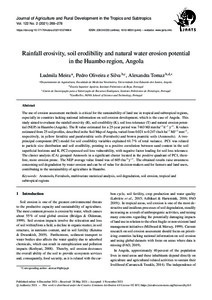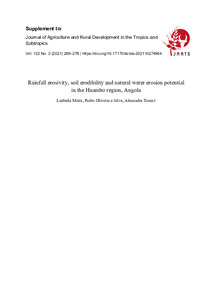| dc.date.accessioned | 2021-12-06T12:19:40Z | |
| dc.date.available | 2021-12-06T12:19:40Z | |
| dc.date.issued | 2021-12-06 | |
| dc.identifier | doi:10.17170/kobra-202110274964 | |
| dc.identifier.uri | http://hdl.handle.net/123456789/13423 | |
| dc.language.iso | eng | eng |
| dc.rights | Namensnennung 4.0 International | * |
| dc.rights.uri | http://creativecommons.org/licenses/by/4.0/ | * |
| dc.subject | arenosols | eng |
| dc.subject | ferralsols | eng |
| dc.subject | multivariate statistical analysis | eng |
| dc.subject | soil degradation | eng |
| dc.subject | tropical and subtropical regions | eng |
| dc.subject.ddc | 630 | |
| dc.title | Rainfall erosivity, soil erodibility and natural water erosion potential in the Huambo region, Angola | eng |
| dc.type | Aufsatz | |
| dcterms.abstract | The use of erosion assessment methods is critical for the sustainability of land use in tropical and subtropical regions, especially in countries lacking national information on soil erosion development, which is the case of Angola. This study aimed to evaluate the rainfall erosivity (R), soil erodibility (K), soil loss tolerance (T) and natural erosion potential (NEP) in Huambo (Angola). The R value estimated for a 25-year period was 7463 MJ·mm·ha-¹·h-¹·y-¹. K values estimated from 25 soil profiles, described in the Soil Map of Angola, varied from 0.021 to 0.247 t·ha·h·ha-1·MJ-¹·mm-¹, respectively, in yellow ferralitic and paraferralitic soils (Ferralsols) and brown psamitic soils (Arenosols). A two-principal component (PC) model for soil erodibility variables explained 61.7% of total variance. PC1 was related to particle size distribution and soil erodibility, pointing to a positive correlation between sand content in the soil superficial horizons and K. PC2 expressed soil loss vulnerability, with negative factor loading for soil loss tolerance. The cluster analysis (CA) grouped Arenosols in a significant cluster located in the positive quadrant of PC1, therefore, more erosion prone. The NEP average value found was of 605 t·ha-¹·y-¹. The obtained results raise awareness concerning soil degradation by water erosion and can be of value for decision-makers and for farmers and land users, contributing to the sustainability of agriculture in Huambo. | eng |
| dcterms.accessRights | open access | |
| dcterms.creator | Meira, Ludmila | |
| dcterms.creator | Oliveira e Silva, Pedro | |
| dcterms.creator | Tomaz, Alexandra | |
| dc.subject.swd | Angola | ger |
| dc.subject.swd | Arenosol | ger |
| dc.subject.swd | Latosol | ger |
| dc.subject.swd | Statistische Analyse | ger |
| dc.subject.swd | Degradation | ger |
| dc.subject.swd | Tropen | ger |
| dc.subject.swd | Subtropen | ger |
| dc.subject.swd | Erosion | ger |
| dc.type.version | publishedVersion | |
| dcterms.source.identifier | eissn:2363-6033 | |
| dcterms.source.issue | No. 2 | |
| dcterms.source.journal | Journal of Agriculture and Rural Development in the Tropics and Subtropics (JARTS) | eng |
| dcterms.source.pageinfo | 269-278 | |
| dcterms.source.volume | Vol. 122 | |
| kup.iskup | false | |



